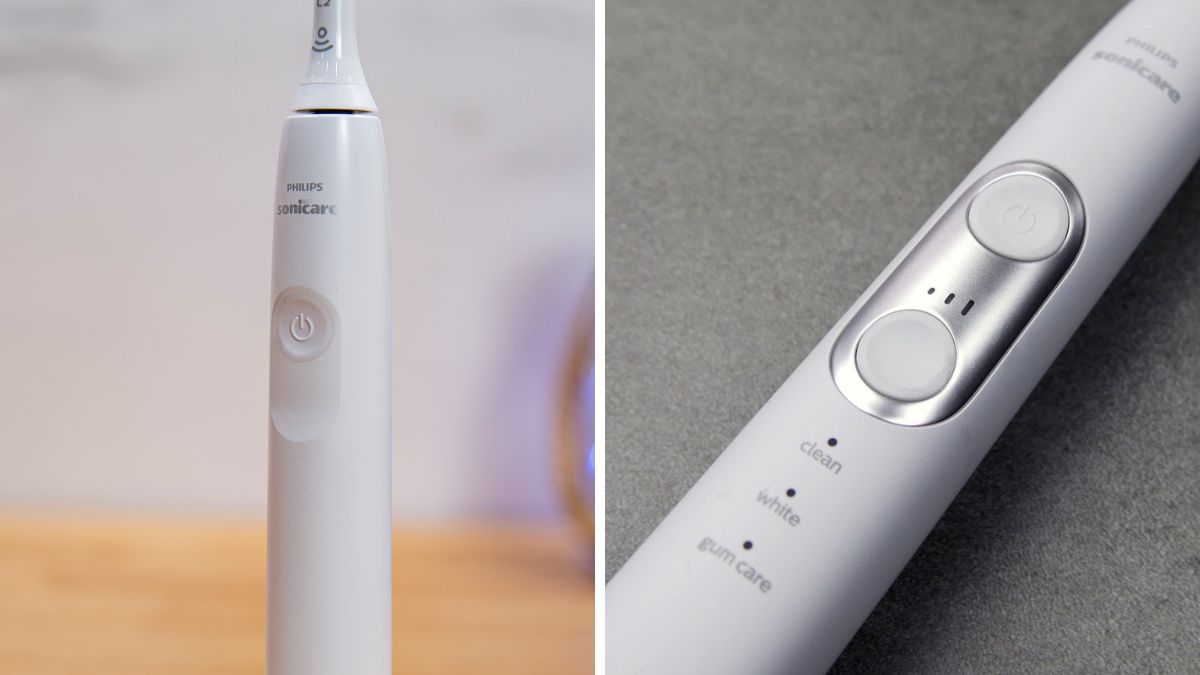
Our choice: 4100 Series
The 4100 Series brush has all the dentist recommended features and is available for a fair price. It is our most recommended Sonicare toothbrush as a result.
For not much extra you can benefit from better battery life and a travel case from the 4500.
If you specifically want additional cleaning modes and more control of the power of the toothbrush, then the 6100 would be the better choice.

Key differences
| Find out more |
| Electric Teeth Rating |
| Retail price |
| Approximate 3 year cost |
| Cleaning Action |
| Number of cleaning modes |
| Brushing intensities |
| Timer |
| Pacer |
| Pressure Sensor |
| Battery life |
| Battery type |
| Number of heads included |
| Travel case included |
| Bluetooth connectivity |
| Position tracking |
| Noise |
| Warranty |
| Buying options |
|
Our Choice

|

|

|
|---|---|---|
| Review | Review | Review |
|
(5)
|
(4)
|
(4)
|
| $80 | $100 | $155 |
| $208 | $226 | $255 |
| Sonic | Sonic | Sonic |
| 1 | 2 | 3 |
| 2 | - | 3 |
|
|
|
|
| 30 second quadpacer | 30 second quadpacer | 30 second quadpacer |
|
|
|
|
| 14 days | 14 days | 14 days |
| Rechargeable Lithium-Ion (Li-Ion) | Rechargeable Lithium-Ion (Li-Ion) | Rechargeable Lithium-Ion (Li-Ion) |
| 1 | 1 | 1 |
| - |
|
|
| - | - | - |
| - | - | - |
| 60dB | 59dB | 64dB |
| 2 years | 2 years | 2 years |
- Cleaning/brushing action
- The 4500 & 6100 ProtectiveClean has the more powerful motor offering up to 62,000 movements compared to the 4100 Series. Actual cleaning results are comparable.
- Handle design/colours
- The 6100 is available in 5 colour options compared to the 3 of the 4100 Series and 2 of the 4500.
- The 4500 & 6100 have LEDs and text labels to show which cleaning modes are selected. The 4100 doesn’t have these.
- The 45 & 6100 have an additional mode/intensity button.
- The 4100 is slimmer and lighter at 3.4 ounces compared to the 4.7 of the 6100.
- Cleaning modes
- The 6100 ProtectiveClean offers 3 cleaning modes (clean, gum care and whitening) compared to 2 of the 4500 (clean & gum care) and 1 (clean) mode of the 4100 Series.
- The 6100 offers 3 brushing intensities compared to the 2 of the 4100. The 4500 ProtectiveClean has no intensity settings.
- The 6100 will automatically select the most appropriate cleaning mode based on the brush head attached.
- Battery
- In my testing, the 6100 & 4500 achieved around 5 weeks of life compared to the 17 days of the 4100.
- Accessories & box contents
- The 4100 is supplied with a C2 Optimal Plaque Control brush head, whereas the 6100 comes with a W DiamondClean and the 4500 a G2 Optimal Gum Care.
- The 4100 Series has a USB charging stand compared to the 2 pin US equipped stand supplied with the 45 and 6100.
- The 4500 and 6100 come with a travel case.
- Price
- The 4100 Series is cheaper, with a retail price of $80 compared to the $100 of the 4500 and $155 of the 6100.
Please note. Every effort is made to ensure the key differences listed are correct, but these differences are subject to change without notice. Products and the box contents can be changed without notice and different variants can exist.
Detailed comparison: what’s the difference between the Sonicare ProtectiveClean 4500, 6100 and 4100 Series?
I can confidently say from my time using all three of these brushes, that what differences exist are in the scheme of things relatively subtle. Picking one brush over the other isn’t going to radically improve your toothbrushing or general dental health. Both clean the teeth well and make for nice brushes to use daily.
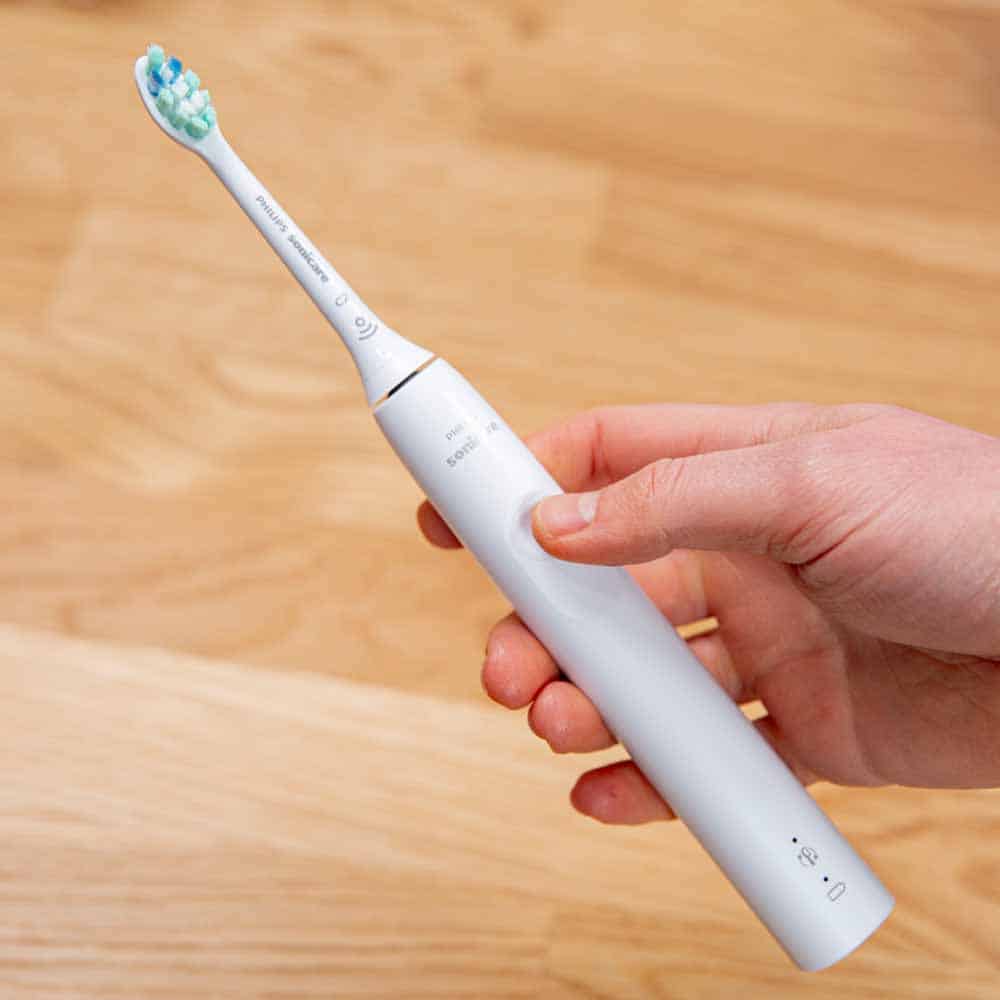
The 4100 Series is technically the newer of the 3 brushes, launching in 2023. Whereas the ProtectiveClean 6100 and 4500 were first introduced in 2017.
The 4100 is noticeably slimmer and lighter. There’s a difference of 35g or 1.3 ounces. A positive for most users as your hand and arm are less likely to tire during use.
| Toothbrush height with head |
| Width |
| Depth/thickness |
| Weight with head |
| Buying options |
|
Philips Sonicare 4100 Series
|
Philips Sonicare ProtectiveClean 4500
|
Philips Sonicare ProtectiveClean 6100
|
|---|---|---|
| 23.4cm / 9.2 inches | 25cm / 9.8 inches | 25cm / 9.8 inches |
| 2.5cm / 0.9 inches | 2.8cm / 1.1 inches | 2.8cm / 1.1 inches |
| 2.7cm / 1 inches | 3cm / 1.1 inches | 3cm / 1.1 inches |
| 97g / 3.4oz | 130g / 4.6oz | 132g / 4.7oz |
Being slimmer might make it slightly more difficult to hold if you or the intended user are unable to form a tight grip on the brush handle. But, we are talking about a few millimetres or points of inches difference.
If the colour of the brush handle is very important to you, then you have a little extra choice with the 6100. At the time of comparison, you have 5 options (white, black, blue, purple & pink) vs 3 of the 4100 (white, black & pink). The 4500 is available in just 2 colours, white and black.
One of the more meaningful differences between these brushes for me is the LEDs and cleaning mode labels available on the 4500 and 6100. You can very clearly see which of the brushing modes you have selected.
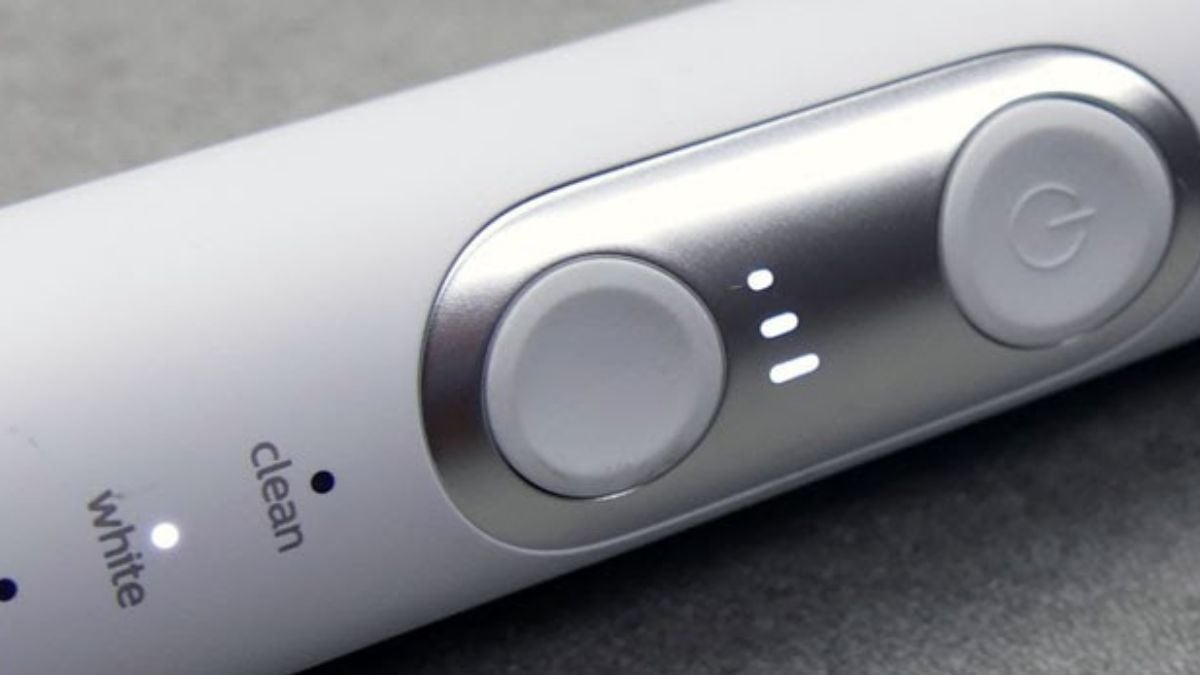
There are no LEDs or labels on the 4100 Series. You can hear and feel the difference between the high and low intensities the 4100 offers. Therefore it’s not a huge inconvenience. But, you don’t get the reassurance that you’ve selected the mode you want, like you do with the ProtectiveClean models. I feel like you have to pay more attention when using the 4100.
A small added benefit of the 45 and 6100 is that you can change modes before turning the brush on. You can’t with the 4100. That’s because the others have an additional mode button.
Although all brushes can use the same brush heads, the 6100 has Brush-Sync mode pairing. This means the handle automatically selects the most appropriate cleaning mode based on the brush head attached. It’s not a must have feature. There is little reason to regularly swap between brush head styles. If you do, it saves 1 or 2 button presses.
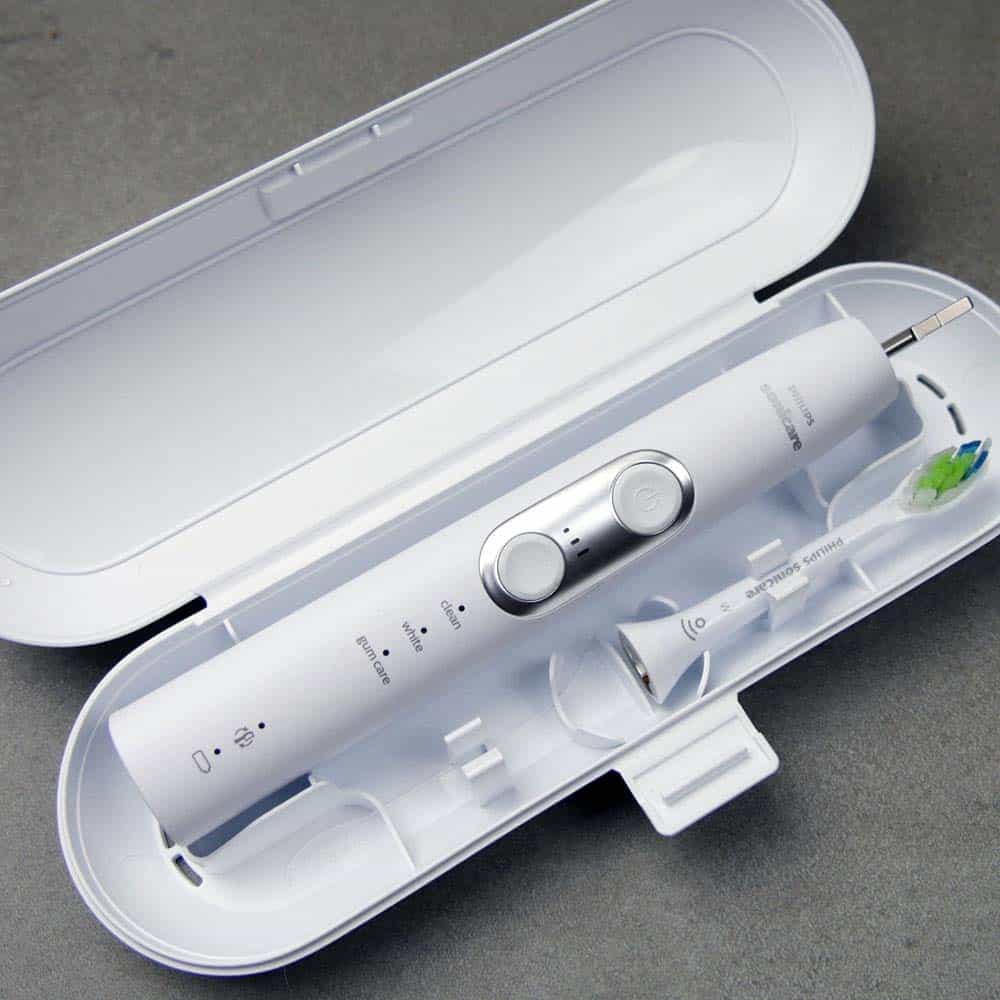
It is the supplied travel case that is the most beneficial extra of the 4500 and 6100 in my opinion. The plastic case holds the handle and up to 2 brush heads. It’s basic, but functional and will benefit regular travellers.
You can get a travel case for the 4100 Series, they are sold separately, or you need to buy the 4900 Series, which comes with one in the box.
It’s not clear whether all brushes use the same battery, but I can confirm both use a rechargeable Lithium-Ion cell. Philips claims 14 days of use on a full charge. I achieved an impressive 5 weeks on the standard clean mode of the ProtectiveClean modes, vs the 17 days of the 4100 Series. This is a fair difference in daily use.
| Battery type |
| Battery life |
| Hands-on battery life |
| Charging stand connector |
| Buying options |
|
Philips Sonicare 4100 Series
|
Philips Sonicare ProtectiveClean 4500
|
Philips Sonicare ProtectiveClean 6100
|
|---|---|---|
| Rechargeable Lithium-Ion (Li-Ion) | Rechargeable Lithium-Ion (Li-Ion) | Rechargeable Lithium-Ion (Li-Ion) |
| 14 days | 14 days | 14 days |
| 17 days | 35 days | 35 days |
| USB Type A | 2 pin US | 2 pin US |
The 4100 has a newer style of charging stand. It has a USB type A cable hardwired into it, compared to the 2 pin power adapter on the 4500 and 6100’s stand.
No USB to 2 pin adapter comes included with the 4100. So to charge from the power outlet you need to buy an adapter or use one you may already own. It’s a bit of an inconvenience for some and might make the 6100 more appealing. It’s not a huge issue and makes the 4100 a better option if you travel, particularly internationally.
Does one clean better than the other?
The short answer is no.
The cleaning results from the 4100 Series or the ProtectiveClean models are comparable, I have no complaints having used them all.
However, there is the potential that the 4500 and 6100 might deliver marginally better results long term. Although I have no clinical evidence to confirm this. This is because the motors of the ProtectiveClean models are configured slightly differently
They deliver up to 62,000 movements per minute, whereas the 4100 Series does not. The 4100 feels slightly less powerful during use.
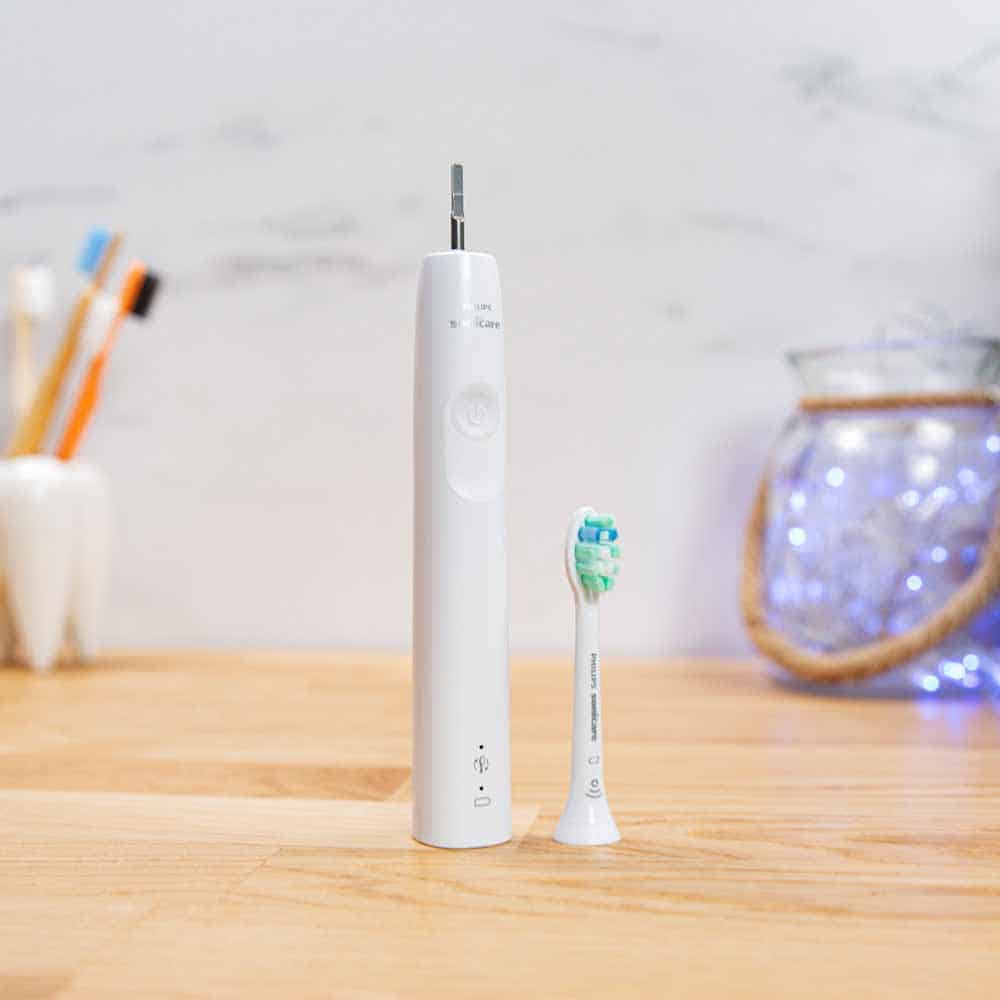
I’ve not found this difference immediately obvious during my testing, because the 4100 has been tuned in such a way it feels very similar.
If you have used a premium Sonicare brush before, you might notice the difference. New sonic toothbrush users have nothing to compare to.
What difference might exist, is very small and will have minimal impact on your overall oral health.
This difference alone is not a reason to opt for the 45 or 6100 in my opinion.
Is one better priced than the other?
Yes, the 4100 Series is the cheaper and more affordable toothbrush.
It has a retail price of $80, almost half that of the $155 of the ProtectiveClean 6100 Series. The 4500 is $100.
I couldn’t justify the $75 premium for the 6100 over the 4100. From my time using both, I don’t feel the 6100 cleans the teeth any better. The extras you are getting and paying for enhance daily usability slightly.
But, a $20 premium for the 4500 is acceptable, given the more powerful motor and the included travel case.
Based on typical selling prices, rather than suggested retailed prices the premium reduces to around $45 for the 6100 over the 4100.
Ongoing costs are comparable as all models use the same brush heads, which typically cost $13 each.
Over 3 years of ownership, you are likely to be about $50 better off by opting for the 4100 Series compared to the 6100 ProtectiveClean.
The 4500 is only about $20 more than the 4100.
Conclusion
These are 3 very good electric toothbrushes that I’ve enjoyed using daily.
Technically the 6100 is the ‘better’ brush, but in everyday use for most people, the 4100 Series is the best option.
It cleans the teeth well, and benefits from the dentist recommended features (timer, pacer and pressure sensor).
The 6100 has several small advantages, notably the customization and control of brushing modes. These don’t have any significant bearing on your oral health.
|
Our Choice

|
Our Choice

|
Our Choice

|
|
|---|---|---|---|
| Electric Teeth Rating |
(5)
|
(4)
|
(4)
|
| Amazon | $59.93 | $79.99 | - |
| Walmart | View price | View price | View price |


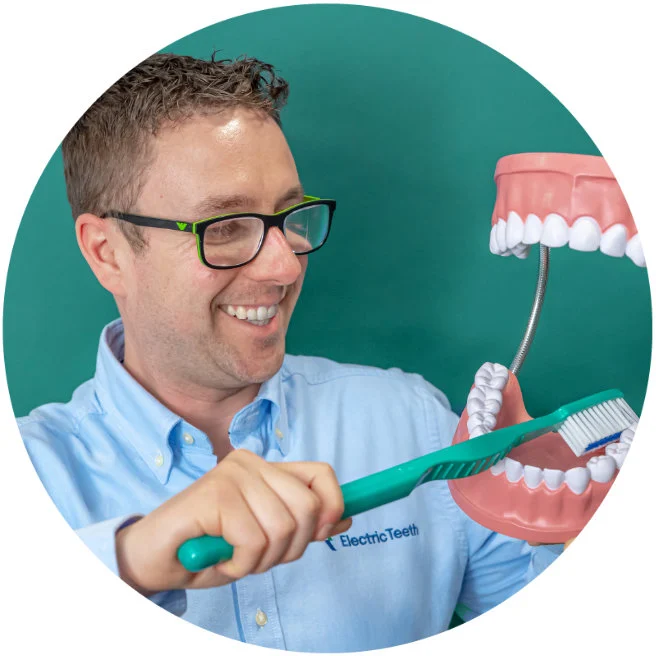
I have a gum issue (lichus planus). Would you recommend the 6100 over the 5100 ?
Which heads are best for sensitive gums?
I look forward to your help with my choice.
Sue,
Either of these should be fine to use. The 6100 does give that extra bit of control around the intensity which you might find useful. It doesn't hurt to get the opinion of your dentist/hygienist.
The G2 Optimal Gum Care brush head is a good all-rounder with soft bristles. You could also try the S Sensitive head too. Just note the S Sensitive head is not BrushSync enabled.
Thank you for your quick response and information.
In your opinion is a big disadvantage to not having the Brushsync enabled…other than not being aware of when it is time to change the head?
Is the Sensitive head much softer than the G2?
Hi Sue.
No, there is no real disadvantage to not having brushsync enabled heads. If you are pretty good at remembering to replace regularly, you can happily proceed without this feature.
As for the softness of the heads I don't have anything to really quantify it with in a meaningful way. I only have my personal feelings/experience. It is quite a bit softer. I think it has a bit to do with the tightness of the bristle clusters.
Is the 5100 & 6100,
100-240V?
Worldwide voltage?
Yes, Sonicare offer 110-240v chargers to support global voltages. You may require a plug adapter, depending where you travel to.